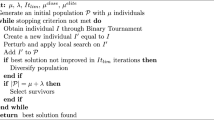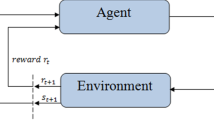Abstract
We consider bi-criteria scheduling problems on a single machine with release dates and rejections and both the makespan and the total rejection cost have to be minimized. We consider three scenarios: (1) minimize the sum of the two objectives: makespan and total rejection cost, (2) minimize the makespan subject to a bound on the total rejection cost and (3) minimize the total rejection cost subject to a bound on the makespan. We summarize the results obtained in the literature and provide for several cases improved approximation algorithms and FPTASs.
Similar content being viewed by others
References
Carnes T, Shmoys D (2008) Primal-dual schema for capacitated covering problems. In: Lodi A, Panconesi A, Rinaldi G (eds) Proceedings of the thirteenth international conference on integer programming and combinatorial optimization (IPCO ‘08). Springer, Berlin, pp 288–302
Csirik J, Frenk JBG, Labbe M, Zhang S (1991) Heuristics for the 0–1 min-knapsack problem. Acta Cybern 10(1–2):15–20
Gens GV, Levner EV (1981) Fast approximation algorithm for job sequencing with deadlines. Discrete Appl Math 3(4):313–318
Graham RL, Lawler EL, Lenstra JK, Rinnooy Kan AHG (1979) Optimization and approximation in deterministic sequencing and scheduling: a survey. Ann Discrete Math 5:287–326
Guntzer M, Jungnickel D (2000) Approximate minimization algorithms for the 0/1 knapsack and subset-sum problem. Oper Res Lett 26(2):55–66
Lu LF, Ng CT, Zhang LQ (2011) Optimal algorithms for single-machine scheduling with rejection to minimize the makespan. Int J Prod Econ 130(2):153–158
Pinedo M (2012) Scheduling—theory, algorithms, and systems, 4th edn. Springer, Berlin
Sahni S (1976) Algorithms for scheduling independent tasks. J ACM 23(1):116–127
Shabtay D, Gaspar N, Kaspi M (2013) A survey on offline scheduling with rejection. J Sched 16:3–28
Slotnick SA (2011) Order acceptance and scheduling: a taxonomy and review. Eur J Oper Res 212:1–11
Tamir A (1998) Fully polynomial approximation schemes for locating a tree-shaped facility: a generalization of the knapsack problem. Discrete Appl Math 87(1):229–243
Zhang LQ, Lu LF, Yuan JJ (2009) Single machine scheduling with release dates and rejection. Eur J Oper Res 198:975–978
Zhang LQ, Lu LF, Yuan JJ (2010) Single-machine scheduling under the job rejection constraint. Theor Comput Sci 411(16):1877–1882
Acknowledgments
Cheng He was supported in part by NSFC Grant 11201121 and CSC 201309895008 and young backbone teachers of Henan colleges 2013GGJS-079. Kangbok Lee was supported in part by PSC CUNY (The City University of New York) Grant TRADA-46-477.
Author information
Authors and Affiliations
Corresponding author
Ethics declarations
Conflict of interest
The authors declare that there is no conflict of interests regarding the publication of this paper.
Appendices
Appendix 1
This appendix describes a heuristic developed by Csirik et al. (1991) and its worst case behaviour. The heuristic is used in the body of the paper.
Let \(\overline{W}_0 := \sum _{j=1}^n w_j - W_0\). It is obvious that \(\sum _{j \in A} w_j \ge \overline{W}_0 \) if and only if \(\sum _{j \in R} w_j \le W_0\). Let \(p_j /w_j\) be defined as the relative processing time of job j.
Algorithm H
Step 1 Sort the jobs in nondecreasing order of their relative processing times. From here on, assume that
Step 2 (a) Let \(k_1\) be the index for which
The sublist \((1, 2, \ldots , k_1+1)\) is a candidate for the solution given by Algorithm H. Let
then this candidate can be written as
(b) Let \(k_1 +2, k_1 + 3, \ldots , k_2 - 1\) be a (possibly empty) series of jobs so that for all corresponding jobs (i.e., \(j \in \{k_1 +2, \ldots k_2 -1 \}\)) the following holds:
Let
then all \(S_1 \cup \{ j\}\), \(j \in \{k_1 + 2, \ldots , k_2 -1 \}\), are also candidate solutions.
(c) Let \(k_2\) be the first next index for which
and let \(k_3 \ge k_2\) be the index for which
Set
Then, \(S_1 \cup S_2 \cup \{{k_3+1} \}\) is also a candidate solution.
Now iterate from (b): in the first iteration use \(k_3\) instead of \(k_1\) and \(k_4\) instead of \(k_2\); in the i-th iteration, use \(k_{2i+1}\) and \(k_{2i+2}\). Repeat this until the end of the list. The solution generated by Algorithm H is the minimum cost candidate.
By applying Algorithm H to problem instance \(\mathcal{J}\), we subdivide \(\mathcal{J}\) into a sequence of alternating sublists as follows:
where the last set is possibly empty, in which case \(k_{2m}-1 = n\). We call the elements in the S-lists small and in the B-lists big.
It is easy to see that Steps 1 and 2 have running times of \(O(n \log n)\) and O(n), respectively. Let \(\sigma _1\) be the schedule obtained by algorithm H and let \(\pi ^*\) be the optimal schedule. Then, it is proved by Csirik et al. (1991) that
Appendix 2: Dynamic programming \(DP^{*}\)
Sort the jobs such that \(r_1\le \ldots \le r_n\). Let \(f_j(t)\) be the minimum value of the total rejection penalty when the jobs under consideration are jobs \(1, \ldots , j\) and the makespan of the accepted jobs among \(1, \ldots , j\) is exactly t. Now, we consider any optimal schedule for the jobs \(1, \ldots , j\) in which the makespan of the accepted jobs among \(1, \ldots , j\) is exactly t.
The initialization is
The recursion relation for \(j = 1, \ldots , n\) is
Hence the optimal objective function value is
Rights and permissions
About this article
Cite this article
He, C., Leung, J.YT., Lee, K. et al. Improved algorithms for single machine scheduling with release dates and rejections. 4OR-Q J Oper Res 14, 41–55 (2016). https://doi.org/10.1007/s10288-016-0303-5
Received:
Revised:
Published:
Issue Date:
DOI: https://doi.org/10.1007/s10288-016-0303-5




